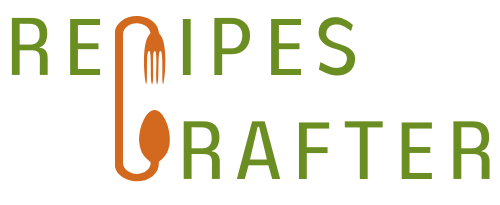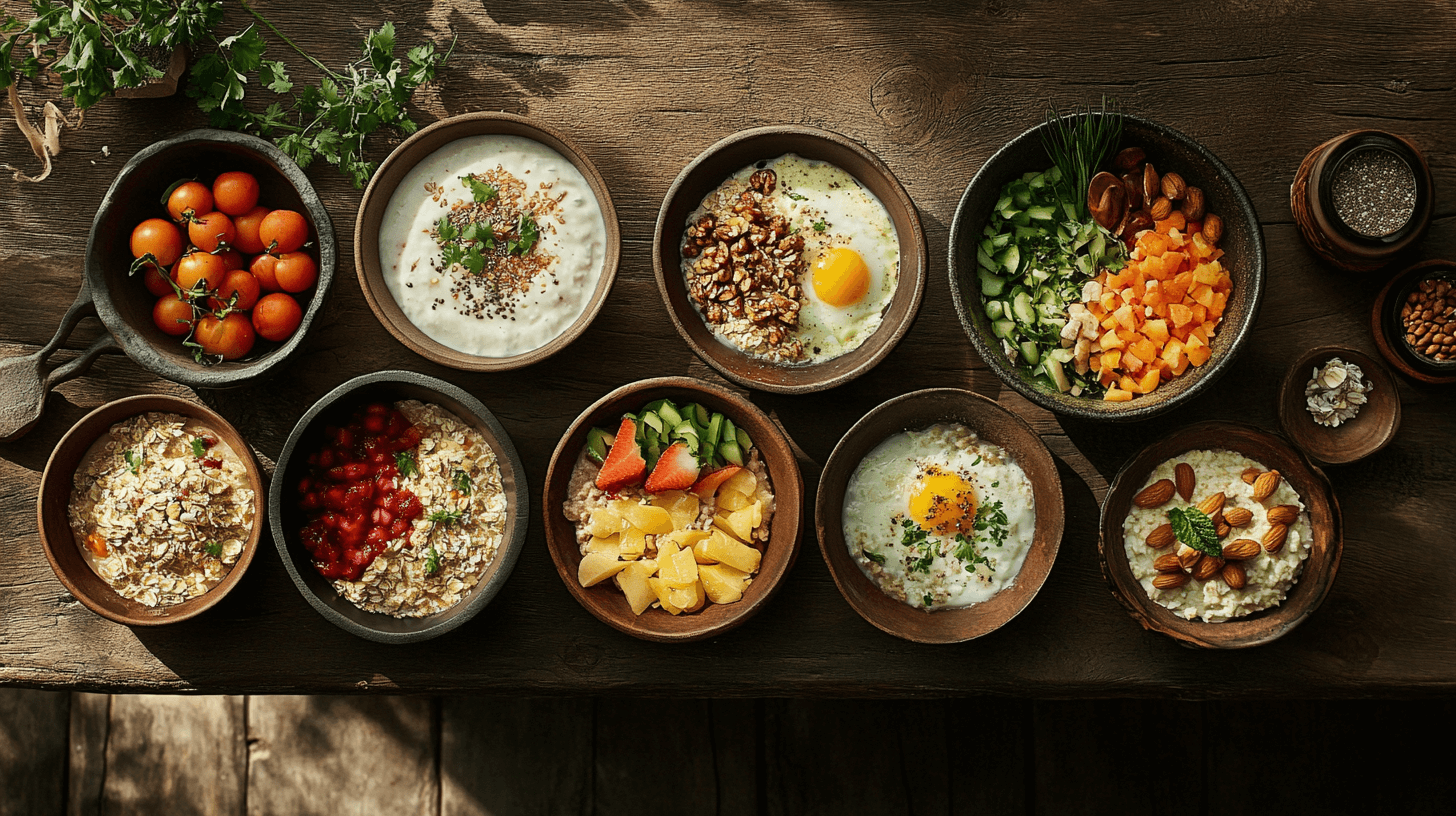Understanding Breakfast Bowls
What Are Breakfast Bowls?
Breakfast bowls are a versatile and delicious way to start the day, combining a variety of ingredients in a single dish that is both nutritious and satisfying. These bowls are typically served in a deep dish or bowl and can be tailored to individual tastes, dietary needs, and nutritional goals. The beauty of breakfast bowls lies in their flexibility—they can be made savory or sweet, hearty or light, and can incorporate ingredients from different cuisines and cultures.
The concept of a breakfast bowl is rooted in convenience and nutrition. By layering ingredients like grains, proteins, vegetables, fruits, and toppings, you can create a well-rounded meal that energizes you for the day ahead. Breakfast bowls are also an excellent way to use leftovers creatively or experiment with new flavors and textures.
Common Ingredients in Breakfast Bowls
Breakfast bowls are all about customization, but certain ingredients are staples depending on the type of bowl you’re creating. Below are some common components:
1. Base Ingredients:
- Grains: Oats, quinoa, rice, or farro.
- Potatoes: Sweet potatoes or hash browns.
- Bread Alternatives: Toast cubes or pancake pieces.
2. Protein Sources:
- Eggs: Scrambled, poached, or fried.
- Meats: Bacon, sausage, or ham.
- Plant-Based Proteins: Tofu, tempeh, or beans.
- Dairy: Greek yogurt, cottage cheese, or milk.
3. Fruits and Vegetables:
- Fruits: Bananas, berries, apples, or mangoes.
- Vegetables: Spinach, kale, avocado, or bell peppers.
4. Toppings and Extras:
- Sweet Toppings: Honey, granola, nuts, or seeds.
- Savory Add-ons: Cheese, salsa, or hot sauce.
- Herbs and Spices: Cinnamon, nutmeg, basil, or parsley.
Types of Breakfast Bowls (Savory vs. Sweet)
Breakfast bowls can be broadly categorized into two main types: savory and sweet. Each offers unique flavors and nutritional benefits.
Savory Breakfast Bowls:
- Typically built around eggs, grains, or potatoes.
- May include cooked vegetables, meats, and cheese.
- Often seasoned with herbs, spices, or condiments.
- Examples:
- A classic egg and sausage bowl with avocado and salsa.
- A Mediterranean-style bowl with quinoa, feta cheese, olives, and spinach.
Sweet Breakfast Bowls:
- Often centered on grains like oatmeal or yogurt.
- Include fruits, nuts, and sweeteners like honey or maple syrup.
- May feature dessert-inspired flavors or fresh, light combinations.
- Examples:
- A fruit and granola parfait with Greek yogurt.
- A chocolate and banana smoothie bowl topped with almonds and chia seeds.
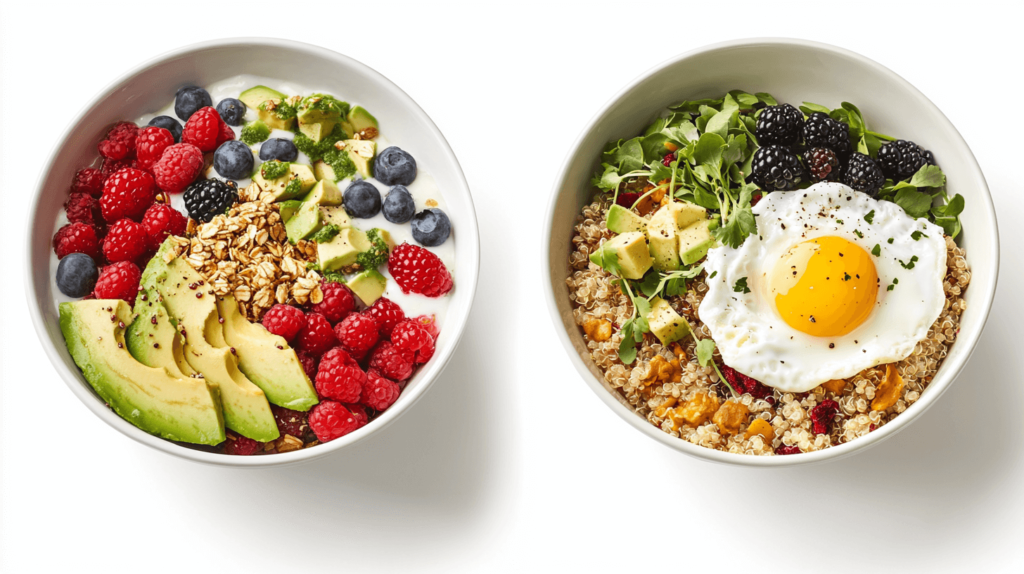
Breakfast bowls are an excellent way to mix and match ingredients, offering endless possibilities for delicious and nourishing meals that cater to every palate and lifestyle.
Nutritional Benefits of a Healthy Breakfast Bowls
Vitamins and Minerals Found in Breakfast Bowls
Breakfast bowls are rich in vitamins and minerals because they incorporate a variety of fresh and nutrient-dense ingredients. The exact nutrients depend on the ingredients used, but common vitamins and minerals include:
- Vitamin C: Found in fruits like oranges, strawberries, and kiwi, it boosts immunity and promotes healthy skin.
- Vitamin A: Present in sweet potatoes, carrots, and spinach, it supports eye health and immune function.
- B Vitamins: Whole grains, eggs, and lean meats are excellent sources that help with energy production and brain function.
- Calcium and Vitamin D: Dairy products such as milk, yogurt, and cheese contribute to bone health.
- Iron: Found in leafy greens, beans, and lean meats, it supports red blood cell production.
- Potassium: Bananas, avocados, and sweet potatoes help maintain healthy blood pressure levels.
Including a variety of colorful fruits, vegetables, and proteins ensures that your breakfast bowl provides a wide array of these essential nutrients.
High Fiber Content and Its Benefits
Many healthy breakfast bowls are high in fiber due to the inclusion of whole grains, fruits, vegetables, and seeds. Fiber offers several health benefits:
- Improved Digestion: Fiber promotes regular bowel movements and prevents constipation.
- Satiety and Weight Management: High-fiber foods keep you feeling full longer, reducing overeating.
- Heart Health: Soluble fiber, found in oats and fruits, helps lower cholesterol levels and supports cardiovascular health.
- Blood Sugar Control: Fiber slows the absorption of sugar, reducing blood sugar spikes and supporting those with diabetes.
Ingredients like oats, chia seeds, quinoa, and fresh fruits are excellent sources of dietary fiber. Incorporating these into your breakfast bowl ensures that you start your day with a nutritious and satisfying meal.
Protein-Packed Options for Muscle Building
Protein is a vital component of healthy breakfast bowls, especially for those focusing on muscle building and repair. Protein supports muscle synthesis, keeps you full, and stabilizes energy levels throughout the day. Here are some protein-rich options for your breakfast bowl:
- Eggs: A complete protein source that is versatile and easy to prepare.
- Greek Yogurt: High in protein and pairs well with sweet or savory toppings.
- Lean Meats: Options like turkey, chicken, or ham add protein without excessive fat.
- Plant-Based Proteins: Tofu, tempeh, and legumes are excellent alternatives for vegetarians and vegans.
- Protein Powders: Blend them into smoothie bowls for an extra protein boost.
Combining protein with other macronutrients, such as healthy fats and complex carbohydrates, creates a balanced breakfast that supports muscle growth and overall health.
Popular Breakfast Bowl Recipes
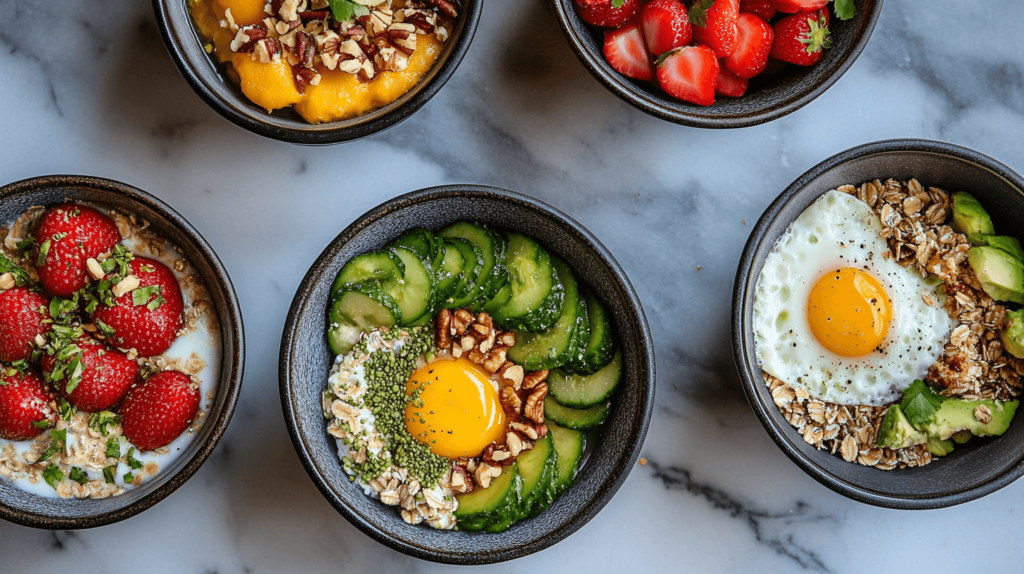
Smoothie Bowls: Health and Variations
Smoothie bowls are a refreshing and nutrient-packed option that combines the goodness of smoothies with the texture and toppings of a traditional breakfast bowl. They are made by blending fruits, vegetables, and liquid bases to create a thick, spoonable consistency. Here’s why they are a favorite:
- Health Benefits:
- High in vitamins and antioxidants from fresh fruits and greens.
- Can be made dairy-free or vegan by using plant-based milk or yogurt.
- Great for hydration and digestion, especially when ingredients like coconut water or chia seeds are included.
- Popular Variations:
- Berry Bliss: A blend of mixed berries, banana, and almond milk, topped with granola, coconut flakes, and fresh berries.
- Green Goddess: Spinach, avocado, banana, and mango blended with coconut water, garnished with kiwi slices, pumpkin seeds, and a drizzle of honey.
- Tropical Delight: Pineapple, mango, and orange juice as the base, with toppings like shredded coconut, papaya, and chia seeds.
Oatmeal Bowls for Long-Lasting Energy
Oatmeal bowls are a hearty and filling option that provides sustained energy throughout the day. Made from whole grains, they are packed with fiber and can be customized for both sweet and savory palates.
- Health Benefits:
- Rich in complex carbohydrates for slow energy release.
- Contain beta-glucan, a type of fiber that helps lower cholesterol.
- Naturally gluten-free (if using certified oats).
- Popular Recipes:
- Classic Cinnamon Apple Oatmeal: Rolled oats cooked with almond milk, topped with sautéed cinnamon apples, walnuts, and a sprinkle of nutmeg.
- Chocolate Banana Bowl: Cocoa powder mixed into oats, garnished with banana slices, dark chocolate chips, and a dollop of peanut butter.
- Savory Herb Oatmeal: Oats prepared with vegetable broth, topped with sautéed mushrooms, spinach, a poached egg, and grated Parmesan.
Savory Breakfast Bowls with Eggs and Veggies
Savory breakfast bowls offer a protein-rich and vegetable-packed start to the day, making them ideal for those who prefer non-sweet breakfast options. They are easy to prepare and can be customized with a variety of ingredients.
- Health Benefits:
- High in protein for muscle repair and satiety.
- Packed with vitamins and minerals from fresh vegetables.
- Low in sugar, making them suitable for blood sugar control.
- Popular Recipes:
- Mediterranean Egg Bowl: Quinoa base with cherry tomatoes, cucumbers, olives, feta cheese, and a soft-boiled egg, drizzled with olive oil and lemon juice.
- Southwest Breakfast Bowl: Scrambled eggs over roasted sweet potatoes, black beans, avocado, and salsa, sprinkled with cilantro and a dash of hot sauce.
- Asian-Inspired Bowl: Brown rice topped with a fried egg, sautéed bok choy, mushrooms, sesame seeds, and soy sauce.
Breakfast bowls are a creative and delicious way to enjoy a wholesome meal, with endless combinations to suit any taste or dietary need. Whether you prefer sweet, hearty oatmeal or savory combinations, there’s a recipe for everyone!
Drawbacks of Breakfast Bowls
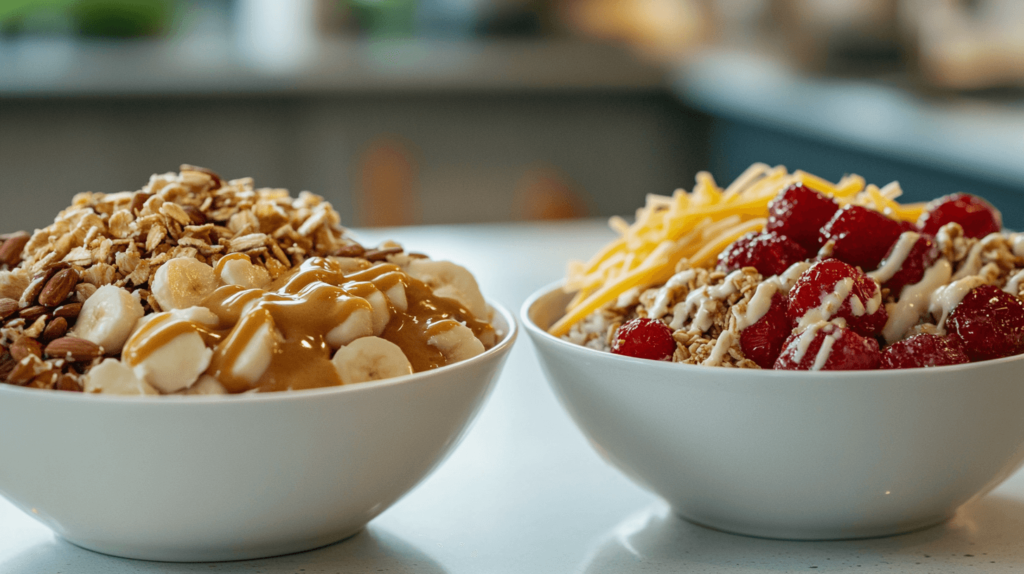
Hidden Calories in Some Recipes
While breakfast bowls can be a healthy choice, some recipes may inadvertently include hidden calories that add up quickly. This is particularly true for bowls loaded with calorie-dense ingredients or excessive toppings. Common culprits include:
- Sweet Additives: Ingredients like honey, maple syrup, or sugary granola can turn a healthy bowl into a high-calorie treat.
- Nut Butters: While nutritious, nut butters like almond or peanut butter are calorie-dense and can contribute to overconsumption if used in large amounts.
- Excessive Oils or Dressings: Savory bowls often include added oils, cheeses, or creamy dressings, which can increase calorie content significantly.
Being mindful of portion sizes and ingredient choices can help manage caloric intake while still enjoying the flavors and benefits of healthy breakfast bowls.
Potential for Unhealthy Additives
Not all breakfast bowls are created equal, and some pre-packaged or restaurant versions may include unhealthy additives that detract from their nutritional value. These can include:
- Artificial Sweeteners and Preservatives: Found in some flavored yogurts, granolas, or pre-made smoothie bases.
- High Sodium Content: Common in savory bowls, especially those made with processed meats, cheeses, or store-bought sauces.
- Refined Sugars: Added to enhance taste but can lead to energy crashes and unnecessary calorie consumption.
To avoid these additives, opt for homemade breakfast bowls using fresh, whole ingredients. When dining out, check ingredient lists or ask about preparation methods to ensure healthier choices.
Portion Control Challenges
Breakfast bowls often appear deceptively small, making it easy to over-serve or overeat. This is especially true for bowls containing calorie-dense ingredients such as nuts, seeds, or grains. Challenges include:
- Large Serving Sizes: Overestimating portion sizes for items like oats, quinoa, or rice can significantly increase calorie intake.
- Overloading Toppings: While toppings add flavor and texture, piling on too many, like fruits, nuts, and syrups, can lead to excessive consumption.
- Balancing Nutrients: It’s easy to skew the balance by including too much of one macronutrient, such as fats or carbohydrates, while neglecting proteins or fiber.
Practicing mindful eating, using measuring tools, and focusing on nutrient-dense ingredients can help maintain portion control and create a balanced, satisfying meal.
While breakfast bowls can be a nutritious and versatile meal option, being aware of these potential drawbacks helps ensure they remain a healthy choice rather than an unintentional calorie trap.
Breakfast Bowls vs. Traditional Breakfasts
Comparison of Nutritional Profiles
Breakfast bowls often provide a more balanced and nutrient-dense option compared to many traditional breakfasts. Here’s a comparison of the two:
- Nutrient Variety: Breakfast bowls allow for a diverse range of ingredients, including whole grains, lean proteins, fruits, and vegetables, offering a broad spectrum of vitamins, minerals, and fiber. Traditional breakfasts, like pancakes, bacon, or pastries, often lack this variety and may be high in refined carbs or saturated fats.
- Macronutrient Balance: With the ability to customize ingredients, breakfast bowls can achieve an ideal balance of proteins, healthy fats, and complex carbohydrates. Traditional options, such as toast with butter, may lean heavily on fats and simple carbs.
- Lower Sugar Content: Many breakfast bowls, especially savory ones, can be low in added sugars, whereas traditional breakfasts like cereals or pastries are often loaded with sugar.
Breakfast bowls have a nutritional advantage when thoughtfully prepared, making them a healthier choice for those seeking balanced meals.
Cost-Effectiveness of Breakfast Bowls
The cost-effectiveness of breakfast bowls compared to traditional breakfasts depends on ingredient choices and preparation methods:
- Affordable Ingredients: Breakfast bowls can be made cost-effective by using staples like oats, frozen fruits, and seasonal vegetables, which are often cheaper than packaged breakfast items like cereals or pre-made pastries.
- Reduced Food Waste: Bowls can incorporate leftovers or small quantities of ingredients, minimizing food waste and maximizing value.
- Pre-Packaged Bowls: Purchasing ready-made breakfast bowls can be more expensive than cooking traditional breakfasts at home. However, homemade bowls can be far more economical.
When made at home with basic ingredients, breakfast bowls can be an affordable and nutritious option compared to dining out or buying processed traditional breakfast items.
Convenience and Preparation Time
Breakfast bowls and traditional breakfasts each offer unique conveniences depending on the situation:
- Preparation Time: Traditional breakfasts like toast or cereal may take less time to prepare, making them convenient for busy mornings. However, with proper meal prep, breakfast bowls can be just as quick and easy to assemble.
- Customization: Breakfast bowls provide greater flexibility to adapt to dietary preferences or nutritional goals, while traditional breakfasts are often limited by fixed recipes.
- Portability: Many breakfast bowls, such as yogurt parfaits or smoothie bowls, are portable and easy to eat on the go. In contrast, items like pancakes or eggs may require sit-down time for consumption.
With a little planning, breakfast bowls can match or even surpass the convenience of traditional breakfasts, offering more nutritional benefits and variety.
Final Thoughts
While traditional breakfasts have their merits in terms of simplicity and nostalgia, breakfast bowls offer greater versatility, enhanced nutrition, and customizable options to suit modern dietary needs. Balancing cost, preparation time, and nutritional benefits makes breakfast bowls a compelling alternative to traditional breakfast fare.
Frequently Asked Questions
Are breakfast bowls good for weight loss?
Yes, breakfast bowls can be an excellent option for weight loss when prepared thoughtfully. They allow you to control portion sizes and include nutrient-dense ingredients such as lean proteins, whole grains, and fiber-rich vegetables or fruits. To maximize weight loss benefits, focus on balanced macronutrients, avoid calorie-dense toppings like excessive nuts or sweeteners, and prioritize low-calorie, high-volume foods like leafy greens or berries.
Can I make breakfast bowls ahead of time?
Absolutely! Breakfast bowls are highly meal-prep friendly. For savory options, cook ingredients like grains, proteins, and vegetables in advance and store them in airtight containers. Sweet bowls like overnight oats or yogurt parfaits can be assembled the night before for a quick grab-and-go meal. Smoothie bowls can also be partially prepped by freezing blended ingredients in portions, ready to be topped fresh.
What are the best protein sources for breakfast bowls?
The best protein sources depend on your dietary preferences, but some popular options include:
- Animal-Based: Eggs, Greek yogurt, cottage cheese, lean meats like turkey or ham, and smoked salmon.
- Plant-Based: Tofu, tempeh, black beans, chickpeas, and quinoa.
- Supplemental: Protein powders (whey or plant-based) for smoothie bowls.
Including a protein source helps promote satiety and supports muscle repair and growth.
Are breakfast bowls expensive to make?
Not necessarily. Breakfast bowls can be cost-effective if you focus on budget-friendly ingredients such as oats, frozen fruits, seasonal vegetables, and bulk-purchased grains or beans. Making them at home is significantly cheaper than purchasing pre-made versions from stores or restaurants. Additionally, using leftovers or minimizing food waste can further reduce costs.
How can I reduce sugar in sweet breakfast bowls?
Reducing sugar in sweet breakfast bowls is simple with a few substitutions:
- Natural Sweeteners: Replace refined sugars with small amounts of honey, maple syrup, or mashed fruits like bananas or dates.
- Flavor Enhancers: Use cinnamon, vanilla extract, or unsweetened cocoa powder to enhance flavor without added sugar.
- Low-Sugar Ingredients: Opt for unsweetened yogurts, plant-based milks, and granolas, and prioritize fresh or frozen fruits over canned varieties.
These strategies keep sugar levels low while maintaining delicious flavor.
Are breakfast bowls suitable for older adults?
Yes, breakfast bowls are an excellent option for older adults due to their adaptability and potential for high nutrient density. Ingredients like whole grains, fruits, vegetables, and lean proteins provide essential vitamins, minerals, and fiber that support healthy aging. For older adults with specific dietary needs, bowls can be customized to include softer textures or nutrient-rich additions like calcium-fortified yogurt and omega-3-rich seeds.
Conclusion: Embracing Breakfast Bowls for Better Health
Summary of Key Benefits
Healthy breakfast bowls are a versatile, nutritious, and customizable meal option that can cater to diverse dietary needs and preferences. They offer:
- A balanced combination of proteins, healthy fats, and complex carbohydrates.
- The inclusion of a wide range of vitamins, minerals, and fiber.
- Adaptability for weight management, meal prep, and budget-friendly cooking.
- Opportunities to explore both sweet and savory flavor profiles.
Encouragement to Experiment with Recipes
The beauty of healthy breakfast bowls lies in their flexibility and creativity. Whether you prefer a berry-packed smoothie bowl, a hearty oatmeal bowl, or a savory egg and veggie combination, the possibilities are endless. Experiment with ingredients, flavors, and textures to find your perfect breakfast bowl. By embracing this nutritious and enjoyable meal format, you can set the tone for a healthier and more energized day!
